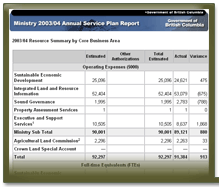 |
|
Report on ResourcesIntroductionThe ministry's performance and accomplishments were achieved with operating expenditures of $89.1 million, 1 per cent less than budgeted and 24 per cent below 2002/03 actual expenditures. Capital expenditures were 21 per cent less than budgeted but 39 per cent larger than in 2002/03. Staff levels were 6 per cent less than budgeted and 21 per cent lower than in 2002/03.
Operating Expenditure VariancesThe 1 per cent under-expenditure in ministry operating expenditures resulted from a workforce adjustment, discussed below, which was greater than budgeted. This was largely offset by some significant unbudgeted expenditures, discussed under Ministry Operating Context. The ministry was able to manage these expenditure pressures, identified early in the fiscal year, by reallocating resources and taking advantage of savings as they arose. The Land Title Branch under the Integrated Land and Resource Information core business area required additional resources to handle a surge in transaction volumes, and these were diverted from most other programs in this core business area, but particularly the loading of data to the land and resource data warehouse and the development of partnerships. Responsibility for provincial contaminated sites was assigned to the ministry and a new program was set up under the Sound Governance core business area after the 2003/04 budget was allocated to the ministry through the Estimates process. The program was unfunded in both operating budget and FTEs, and this fully accounts for the variance in this core business area. Savings were generated in the Executive and Support Services core business area from reduced overhead costs and other measures to ensure that the ministry remained within its overall budget in 2003/04 and to prepare for the 2004/05 target budget. Staffing and Workforce AdjustmentThe ministry reduced its workforce by 21 per cent in terms of staff utilized, 4 percentage points more than planned. This occurred largely in the core business areas of Sustainable Economic Development, Integrated Land and Resource Information and Executive and Support Services, which account for 96 per cent of the ministry's operating expenditures. It was largely due to the unpredictable impacts of incentive programs for early retirement and voluntary departure, plus delays resulting from changes in recruitment practices. The unfunded introduction of the contaminated sites program resulted in a reallocation of additional staff resources to Sound Governance after the 2003/04 budget was allocated, and accounts for the variance in this core business area. Capital Expenditure VarianceThe ministry has focused on maximizing the effectiveness of capital expenditures to meet service plan goals, while at the same time controlling future amortization costs resulting from these capital expenditures. As a result, the ministry under-spent its budget by 21 per cent, although its expenditures were considerably higher than in the previous year when expenditures were under-spent by approximately the same percentage and for the same reason. Capital spending has been focused on the development of information systems required to support the ministry and client needs. Operating Expenditures by GoalsThe ministry's operating expenditures by goal are shown in the Overview of Ministry Goals, beginning on page 29, and comments are provided there on changes from 2002/03. They have been calculated by estimating the Goal 4 expenditures under each core business area. Goal 4 expenditures were lower than in 2002/03 due to a greater use of central training services.
|
|||||||||||||||||||||||||||||
|
||||||||||||||||||||||||||||||

